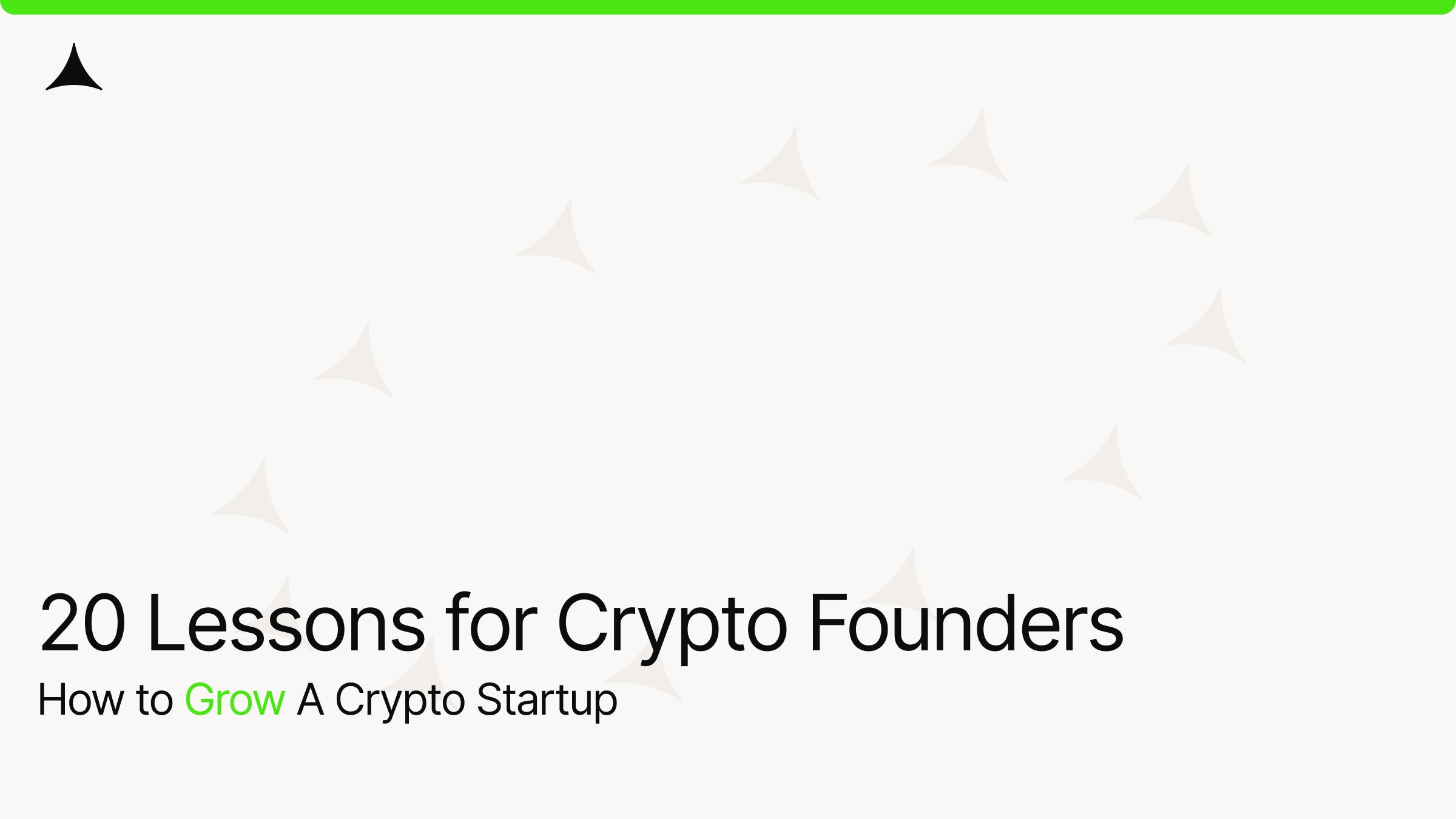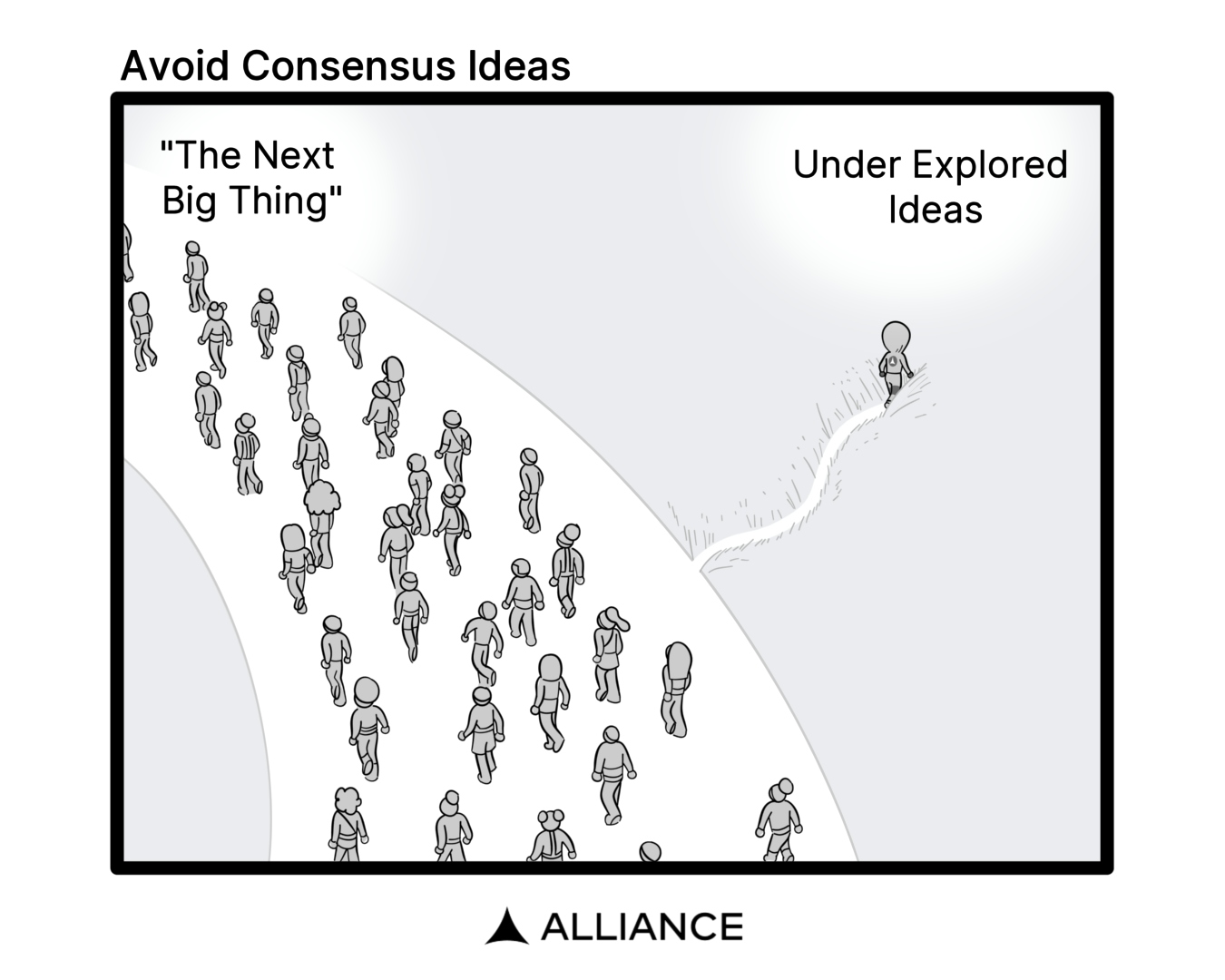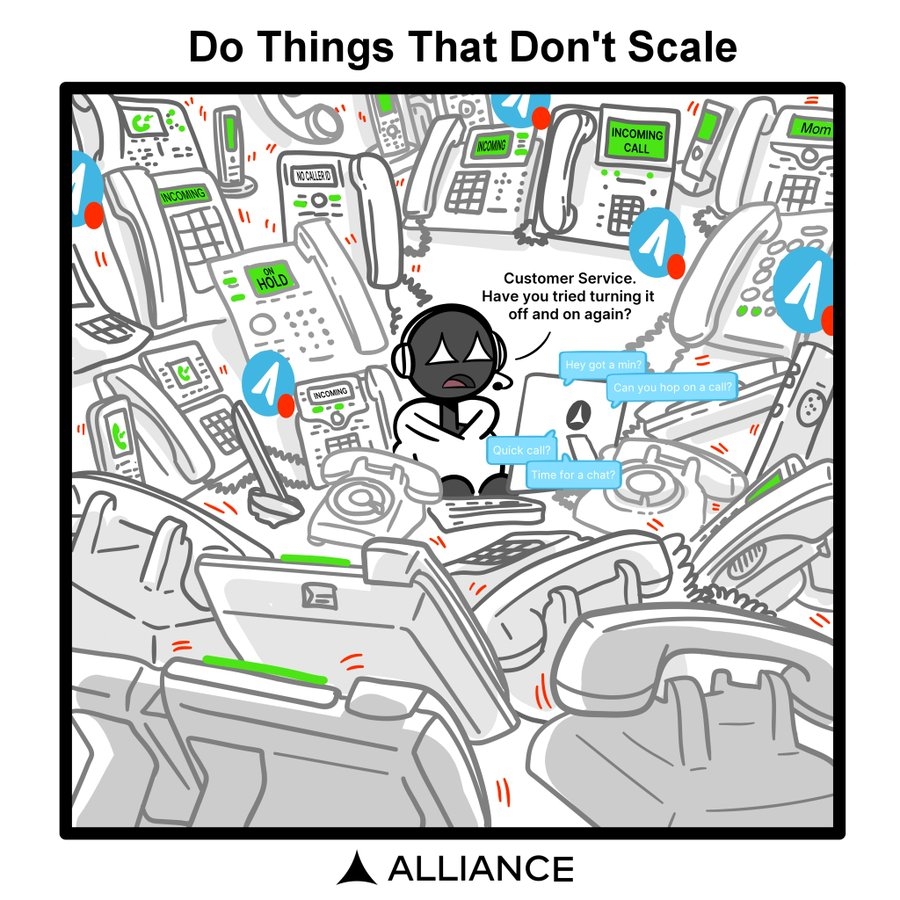20 Lessons for Crypto Founders

Imran Khan
·Oct 18, 2024

I recently gave a keynote at Solana Breakpoint with the goal to pack as much actionable information for crypto founders into the time I had as possible. It was pretty well received so figured I’d take some time to elaborate a bit and give people a quick place to find each piece of advice.
1. Start with a Small Problem or Design Space
Instead of targeting a massive market from the start, focus on solving a small, specific problem. This approach often contradicts what VCs suggest, as they tend to push for addressing large markets. Instead, zero in on issues affecting a smaller group of users — ones that you can experience firsthand by using crypto products daily. With thousands of new products launching constantly, use as many as possible to understand the pain points that everyday users face. By doing so, you'll identify real, actionable problems that need solving.
Starting small allows you to deeply understand your users' needs and refine your product without the noise and complexity of a larger market.
2. Avoid Consensus Ideas
Avoid chasing ideas that everyone agrees are the next big thing. When an idea is universally accepted, the market is often already saturated. Take Polymarket as an example: now that they've validated prediction markets, there are hundreds of teams building in this space. The time to innovate was when only Polymarket was active, not after validation. Competing against established players requires a product that's 10x better to stand out. Instead, focus on underexplored areas where competition is less intense. This gives you the freedom to experiment and the time to develop a unique value proposition.

3. Build for a Small Group of Users
Identify a core group of early adopters—around 25 to 50 passionate individuals—who truly care about the problem you're solving. By focusing on their specific needs, you can build a strong foundation and foster genuine advocacy. These early users will provide invaluable feedback, helping you iterate quickly and improve your product. Over time, this process will help grow your user base organically. If people love what you've built, it's not unrealistic to expect them to naturally refer friends and family to it.

4. Validate Your Thesis with an MVP
Before investing significant resources like capital and time, validate your core assumptions with a Minimum Viable Product (MVP). This simplified version of your product should focus on solving the primary pain point you've identified. You want to release something that is barebones but provides enough insights to either double down or pivot to a different idea. It also allows you to gather feedback from users more quickly, and you may learn something entirely unexpected. Additionally, launching quickly keeps you ahead of the competition—many others are likely considering the same idea, and it's often the first to launch that captures the initial attention.
5. Launch Your Ideas Within 30 Days
Time-to-market is crucial. Aim to develop and launch your MVP within 30 days to capitalize on the momentum of your idea and to start collecting user data as soon as possible. This rapid deployment forces you to prioritize essential features and avoids the pitfalls of over-planning.
6. Do Things That Don't Scale
In the early stages, personal touches matter more than building a full fledged product. Engage directly with users, handle customer support yourself, and manually execute transactions that will later be automated. These unscalable efforts help you build strong relationships with your initial user base and provide deep insights into their needs and behaviors. This approach enables you to build and launch quickly, but more importantly, it gets a product into users' hands as soon as possible.

7. Don't Overbuild; Use Existing Tools to Simulate
Avoid the temptation to create everything from scratch. For crypto founders, it's best to avoid building core infrastructure and instead partner with or use existing products to simulate the end offering. For example, use off-the-shelf AMMs like Uniswap or Raydium rather than developing your own AMM for specific products. This approach conserves resources and allows you to focus on refining your core offering
8. Recruit Your Users One-by-One Until You Reach 50
Personal outreach is invaluable when building your initial user base. Reach out to potential users individually through emails, social media platforms like Twitter DMs, or community forums. This approach allows you to engage with willing users and receive precise, candid feedback about your product.
9. Ask for Feedback Constantly and Iterate the Product
Maintain an ongoing dialogue with your users. Regular feedback sessions can reveal insights that you might not have considered. Use this feedback to make iterative improvements to your product, ensuring it continues to meet the evolving needs of your user base. Creating this feedback loop is crucial because it keeps you closely connected to users’ needs, allowing you to build a product that people genuinely love. Famously, Alon from Pump.fun DM'd 3,000 Twitter users before Pump gained traction
10. Don't Take Feedback Literally
While user feedback is essential, it's important to interpret it carefully. Users may not always articulate their needs accurately or may suggest solutions that don't align with your vision. Use your judgment to discern the underlying issues and address them in a way that stays true to your product's direction.
11. Achieve Consistency with 50-100 Daily Active Users
Aim for a steady increase in daily active users (DAUs), targeting consistency with 50-100 DAUs as an initial milestone. This level of engagement indicates that your product is gaining traction and becoming a part of users' regular activities. Monitor retention rates and user engagement metrics to ensure you're building sustainable growth.
12. Work on Your Business Model
Once you have a consistent user base, it's time to focus on monetization. Develop a clear business model that outlines how your startup will generate revenue. Whether it's transaction fees, premium features, or token sales, a well-defined business model is crucial for attracting investors and ensuring long-term viability.
13. Drill Down on Metrics and Figure Out Growth
Data is your ally. Dive deep into your analytics to understand what's driving user acquisition, engagement, and retention. Identify key performance indicators (KPIs) that align with your business goals. Use this data to make informed decisions about marketing strategies, product features, and resource allocation.
14. Be Persistent: Email, DM in Group Chats, Use Social Platforms
Persistence pays off. Don't hesitate to reach out multiple times to potential users, partners, or investors. Ise various channels like email, direct messages, group chats, and social media to broaden your reach. Building a startup often requires relentless networking and promotion. Always Be Closing (ABC).
15. Celebrate Small Wins and Take Short Breaks
Recognize and celebrate milestones, no matter how small. Whether it's launching a new feature or reaching a user benchmark, acknowledging progress keeps morale high. Additionally, taking short breaks helps prevent burnout, allowing you and your team to maintain high levels of productivity over the long haul.
16. Work Hard
There's no substitute for hard work. Building a successful startup requires dedication, long hours, and a willingness to go above and beyond. Your commitment sets the tone for your team and can be the difference between success and failure. Think about it this way: if your competitors are working on their idea 7-8 hours a day, how many hours are you willing to work to win? Now, I'm not suggesting you simply work harder by putting in more hours, but that thought should motivate you to work smarter and win.
17. Protect Your Equity
Be mindful of how much equity you give away, especially in the early stages. It can be tempting to offer significant equity to secure funding or talent, but retaining control is crucial for shaping your company's future. Consider alternative incentives and negotiate terms that align with your long-term vision. In the end, founders should retain enough skin in the game to be rewarded for all the long hours they invest in the earliest stages.
18. Raising Little Will Teach You to Do More with Less
Securing modest funding forces you to prioritize and be resourceful. In the earliest stages, you should typically aim to raise between $500K and $1M at most. Operating on a lean budget encourages founders to find creative solutions to problems. This discipline can lead to a more sustainable business model and make you more attractive to future investors. Famously, Jeff Bezos used a door as his desk to remind himself to be resourceful with both time and capital.
19. Be Frugal, Be Frugal, Be Frugal
Adopt a frugal mindset across all aspects of your startup. Scrutinize expenses, avoid unnecessary overhead, and focus spending on areas that directly contribute to growth. Frugality extends your runway and provides flexibility to navigate unexpected challenges or market shifts.
20. Hire and Stay Lean as Long as Possible
Expand your team cautiously. Each new hire should fulfill a critical role that directly impacts your startup's success. A lean team is more agile, easier to manage, and less prone to the complexities that come with larger startups. Staying lean allows you to pivot quickly and maintain a strong company culture. Company culture can also degrade rapidly if you hire too many people.
Watch the original talk below ↓
More to Read
You're Vibe Coding Wrong

Mohamed Elseidy
·Jul 10
Most developers use Tier 1 for UX & rapid prototyping, Tier 2 for daily development, and Tier 3 for complex engineering challenges. The best strategy is to combine them when needed rather than trying to force one tool to do everything. Here's what each tier actually delivers and when you should use them
Your Moat Isn't Your AI Prompt. It's Your Evaluations

Mohamed Elseidy
·Jun 17
Anyone can copy a prompt, but they can't replicate the months of iterative learning, the domain knowledge and the edge cases discovered through real user interactions, and the systematic evaluation framework that guided every prompt tweaking decision.
Shopping is Dead, AI is Taking Over

Mohamed Elseidy
·May 28
Major payment networks are building the infrastructure while AI platforms began to deploy; for startups, this opens opportunities in vertical specialization and merchant tools; and SEO will evolve into AEO as businesses adapt to optimize for AI agents rather than human shoppers.